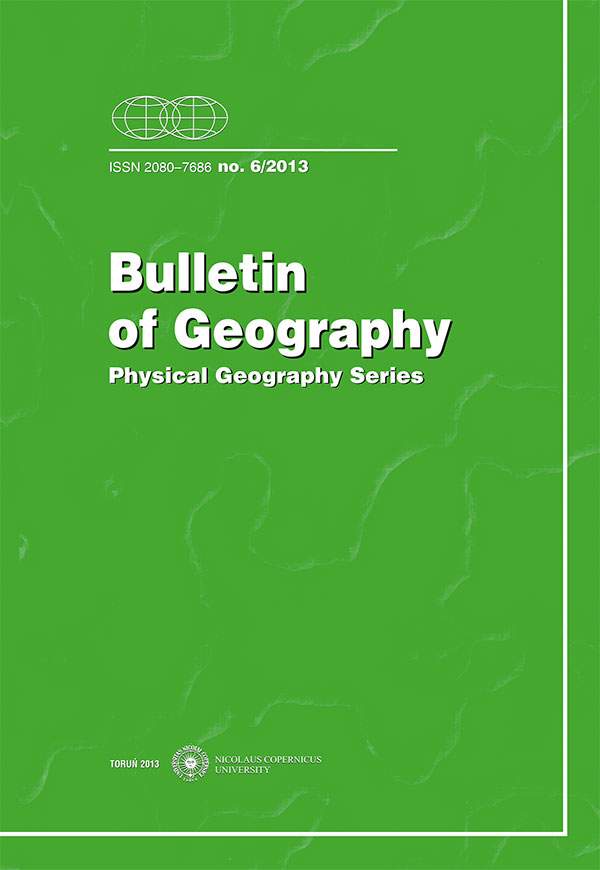FREQUENCY OF ICE DAYS AT SELECTED METEOROLOGICAL STATIONS IN SVALBARD
DOI:
https://doi.org/10.2478/bgeo-2013-0005Keywords
maximum air temperature, ice days, circulation indices, Svalbard, ArcticAbstract
The paper aims to present research into both the long-term variability in the ice days in Svalbard representing the Atlantic sector of the Arctic, and their relations to atmospheric circulation. Ice days are defined as days with a daily maximum temperature below 0°C (Tmax<0°C). They are considered to be amongst the most important indices of current climate change. All the available data on daily maximum air temperature from three Norwegian stations (Svalbard Airport (Svalbard Lufthavn), Bjørnøya and Hopen) and from the Polish Polar Station in Hornsund (SW Spitsbergen) have been employed. The relevance of atmospheric circulation to the frequency of the occurrence of ice days was evaluated by calculating the Spearman correlation coefficients between the frequency of ice days and three regional circulation indices: zonal westerly circulation index (W), meridional southerly circulation index (S) and index of cyclonicity (C). At all the stations the number of ice days exhibited significant decreasing trends in the period of 1979-2012.
References
BEDNORZ E., 2011, Occurrence of winter air temperature extremes in Central Spitsbergen, Theor. Appl. Climatol., 106(3–4), 547–556.
FØRLAND E.J., HANSSEN-BAUER I. and NORDLI P.Ø., 1997, Climate statistics and long term series of temperature and precipitation at Svalbard and Jan Mayen, DNMI—Rapport, 21/97. Norwegian Meteorological Institute, Oslo
FØRLAND E.J. and HANSSEN-BAUER I., 2003, Past and future climate variations in the Norwegian Arctic: overview and novel analyses, Polar Res., 22(2), 113– 124.
GLICKMAN T.S. (ed.), 2000, Glossary of Meteorology, Second Edition, American Meteorological Society, Boston Massachusetts, U.S.A., 855 pp.
INSTITUTE OF GEOPHYSICS POLISH ACADEMY OF SCIENCE, 2001, Meteorological conditions Hornsund, Spitsbergen 2000/2001, Publications of the Institute of Geophysics Polish Academy of Science, D-57(341).
INSTITUTE OF GEOPHYSICS POLISH ACADEMY OF SCIENCE, 2003. Meteorological conditions Hornsund, Spitsbergen 2001/2002, Publications of the Institute of Geophysics Polish Academy of Science, D-60(351).
INSTYTUT GEOFIZYKI PAN, 2009-2013, Biuletyn meteorologiczny – Spitsbergen – Hornsund (Meteorological Bulletin – Spitsbergen – Hornsund), 2009.10-2013.03 (available on line at: www.glacio-topoclim.org/index.php/ reports).
KLEIN TANK A.M.G. and COAUTHORS, 2002, Daily dataset of 20th-century surface air temperature and precipitation series for the European Climate Assessment, Int. J. Climatol., 22, 1441–1453. Data and metadata available at http://www.ecad.eu
MARSZ A.A., 2013, Air temperature, [in:] Marsz A.A., Styszyńska A. (eds), 2013, Climate and climate change at Hornsund, Svalbard, Maritime University, Gdynia, 145-187.
MARSZ A.A. and STYSZYŃSKA A. (eds), 2013, Climate and climate change at Hornsund, Svalbard, Maritime University, Gdynia, 402 pp.
MIĘTUS M. (ed.), 2000-2001, Roczniki Meteorologiczne Hornsund (Meteorological Yearbooks Hornsund) (1978/79–1980/81, 1982/83–1999/2000). Instytut Meteorologii i Gospodarki Wodnej Oddział Morski, Gdynia.
MURRAY R. and LEWIS R.P., 1966, Some aspects of the synoptic climatology of the British Isles as measured by simple indices, Meteorol. Magazine, 95, 193–203.
NIEDŹWIEDŹ T., ŁUPIKASZA E. and MAŁARZEWSKI Ł., 2012. Wpływ cyrkulacji atmosfery na występowanie dni mroźnych w Hornsundzie (Spitsbergen) (The influence of the atmospheric circulation on the occurrence of ice days in Hornsund (Spitsbergen), Probl. Klimatol. Pol., Gdynia, 22, 17–26 (in Polish, summary in English).
NIEDŹWIEDŹ T., 2013a, The atmospheric circulation, [in:] MARSZ A.A., STYSZYŃSKA A. (eds), 2013, Climate and climate change at Hornsund, Svalbard, Maritime University, Gdynia, 57–74.
NIEDŹWIEDŹ T., 2013b, Catalogue of circulation types above Spitsbergen (1951– 2013), Department of Climatology, Faculty of Earth Sciences, University of Silesia, Sosnowiec, Poland. Computer file available on line at http://klimat. wnoz.us.edu.pl.
NORDLI P.Ø., 1990, Temperature and precipitation series at Norwegian Arctic meteorological stations, DNMI KLIMA. Rapport 40(90), 1–14.
NORDLI P.Ø., 2005, Long-term temperature trends and variability at Svalbard (1911–2004), Geophys., Res. Abstracts, 7(06939), SRef-ID: 1607-7962/gra/ EGU05-A-06939.
NORDLI P.Ø., HANSSEN-BAUER I. and FØRLAND E.J., 1996, Homogeneity analyses of temperature and precipitation series from Svalbard and Jan Mayen, DNMI-klima. No. 16/96, 41 pp.
PRZYBYLAK R., 2007, Recent air-temperature changes in the Arctic, Annales Glaciol., 46, 316–324.
SERREZE M.C., BOX R.G., BARRY R.G. and WALSH J.E., 1993, Characteristics of Arctic synoptic activity, Mete. and Atmos. Phys., 51(3), 147–164.
SERREZE M.C. and FRANCIS J.A., 2006, The Arctic amplification debate, Clim. Change, 76, 241–264.
STEFFENSEN E.L., 1982, The climate at Norwegian Arctic stations, Det Norske Meteorologiske Institutt, Klima nr.5, Oslo.
TUOMENVIRTA H., ALEXANDERSSON H., DREBS A., FRICH P. and NORDLI P.Ø., 2000, Trends in Nordic and Arctic temperature extremes and ranges, J. Climate, 13(3), 977–990.
USTRNUL Z., 1987, Some characteristics of air thermal conditions in Hornsund, Spitsbergen, Polish Polar Res., 8 (3), 261–275.
VALOR G.B., 2013, OGIMET – Professional information about meteorological conditions in the world (SYNOP messages available on-line on the web site: http://www.ogimet.com). Last access 17 August 2013.
Downloads
Published
How to Cite
Issue
Section
Stats
Number of views and downloads: 393
Number of citations: 0



